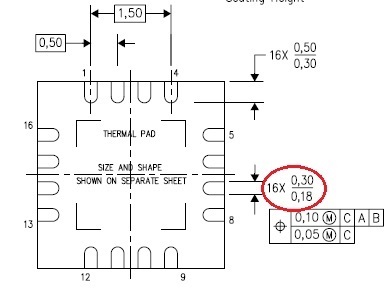Other Parts Discussed in Thread: LM5085
Team,
Customer has some PCB manufacturing requirements that are imposed by the application and PCB manufacturer.
For the BQ24640RVA the PCB manufacturer need to use a PAD width of 0.2mm (see picture below).
1)Can a 0.2mm PAD width be used for this package? Can a reliable soldering and long term device operation be garanty with this width?
2) Do we plan to have more industrial friendly package for the BQ24640 device? Or to have other supercap charger device in other package in the future? Any timeline?
3) I have seen the below FAQs page for QFN:
http://www.ti.com/support-quality/faqs/qfn-son-faqs.html
The "QFN/SON PCB Attachment -SLUA271A" app note does not seem to be listed there.
Is this app note relevant for S-VQFN-N16 too? Or is there a document specific for S-VQFN-N16?
Thanks in advance,
Anthony


